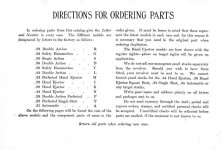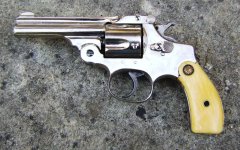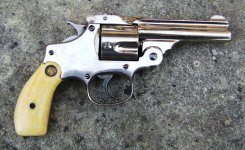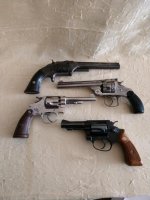Can anyone date this old top-break S&W revover? My Son-in-Law found this while cleaning out the basement of his mother's house. It appears to be in near perfect condition. Here is what I know about it:
It is a top-break I frame, 5 shot, 38 S&W (that's pre-38 Spl). The cylinder is 1.25" in length. The barrel is 4 in. It has 5 screws, including the screw in the front of the trigger guard. Round butt and rounded front blade sight with a fixed rounded notch rear sight. It auto-ejects when you open it. Hammer is visible. There is a strain screw on the front of the grip strap. S/N 55885.
This is obviously a C&R gun. But I would like to tell my Son-in-Law how old it is and what model it is, if there is one (model number isn't stamped). And this is important, I read somewhere that it may not be wise to use smokeless powder in this gun. But that should depend on just how old this gun is. Any advice on that would be appreciated.
If no one can date this gun, my next step would be the Smith & Wesson Historical Foundation - Smith & Wesson Historical Foundation - Home Page - Insuring that the rich history of Smith & Wesson will continue for generations to come. I suspect y'all are just going to tell me to go directly there anyway. But, maybe someone already knows about this gun.







It is a top-break I frame, 5 shot, 38 S&W (that's pre-38 Spl). The cylinder is 1.25" in length. The barrel is 4 in. It has 5 screws, including the screw in the front of the trigger guard. Round butt and rounded front blade sight with a fixed rounded notch rear sight. It auto-ejects when you open it. Hammer is visible. There is a strain screw on the front of the grip strap. S/N 55885.
This is obviously a C&R gun. But I would like to tell my Son-in-Law how old it is and what model it is, if there is one (model number isn't stamped). And this is important, I read somewhere that it may not be wise to use smokeless powder in this gun. But that should depend on just how old this gun is. Any advice on that would be appreciated.
If no one can date this gun, my next step would be the Smith & Wesson Historical Foundation - Smith & Wesson Historical Foundation - Home Page - Insuring that the rich history of Smith & Wesson will continue for generations to come. I suspect y'all are just going to tell me to go directly there anyway. But, maybe someone already knows about this gun.

















